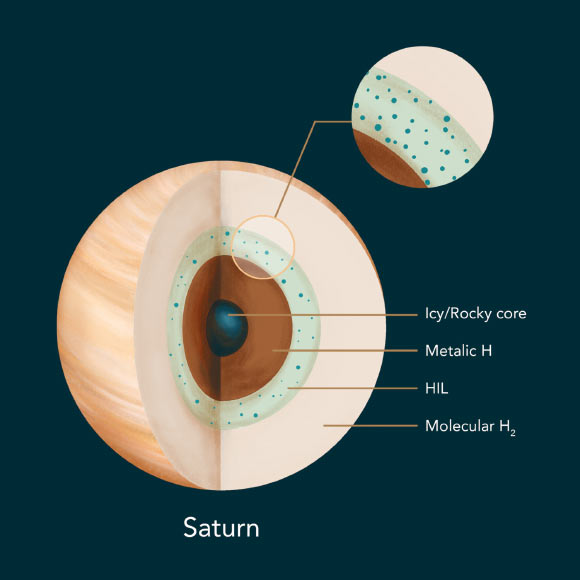Detailed measurements from the Grand Finale phase of NASA’s Cassini mission revealed distinctive features of Saturn’s magnetic field. These features provided critical constraints on Saturn’s deep interior where its magnetic field is generated. In new research, a duo of planetary scientists at Johns Hopkins University used computer simulations to explore whether the implementation of a helium rain layer at the top of Saturn’s dynamo region could help reproduce a magnetic field resembling the gas giant’s surface magnetic field features.

Saturn’s interior with a stably stratified helium insoluble layer (HIL). Image credit: Yi Zheng, HEMI / MICA Extreme Arts Program.
“By studying how Saturn formed and how it evolved over time, we can learn a lot about the formation of other planets similar to Saturn within our own Solar System, as well as beyond it,” said Professor Sabine Stanley, a planetary physicist in the Department of Earth and Planetary Sciences and the Applied Physics Laboratory at Johns Hopkins University.
“Saturn stands out among the planets in our Solar System because its magnetic field appears to be almost perfectly symmetrical around the rotation axis.”
“Detailed measurements of the magnetic field gleaned from the last orbits of NASA’s Cassini mission provide an opportunity to better understand the planet’s deep interior, where the magnetic field is generated,” said Chi Yan, a Ph.D. candidate in the Department of Earth and Planetary Sciences at Johns Hopkins University
By feeding Cassini data into powerful computer simulations similar to those used to study weather and climate, the researchers explored what ingredients are necessary to produce the dynamo — the electromagnetic conversion mechanism — that could account for Saturn’s magnetic field.
“One thing we discovered was how sensitive the model was to very specific things like temperature,” Professor Stanley said.
“And that means we have a really interesting probe of Saturn’s deep interior as far as 20,000 km down. It’s a kind of X-ray vision.”
Strikingly, the team’s simulations suggest that a slight degree of non-axisymmetry could actually exist near Saturn’s north and south poles.
“Even though the observations we have from Saturn look perfectly symmetrical, in our computer simulations we can fully interrogate the field,” Professor Stanley said.
“Direct observation at the poles would be necessary to confirm it, but the finding could have implications for understanding another problem that has vexed scientists for decades: how to measure the rate at which Saturn rotates, or, in other words, the length of a day on the planet.”
The findings are published in the journal AGU Advances.
_____
C. Yan & S. Stanley. Recipe for a Saturn-Like Dynamo. AGU Advances, published online May 5, 2021; doi: 10.1029/2020AV000318







